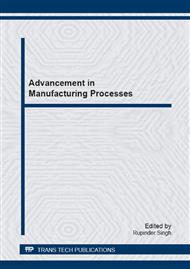p.19
p.35
p.43
p.51
p.65
p.79
p.89
p.97
p.103
Modeling of Dimensional Accuracy in Three Dimensional Printing for Light Alloy Casting
Abstract:
The purpose of this paper is to develop mathematical model to investigate the influence of shell casting parameters. Three input parameters such as shell wall thickness (SWT), Pouring temperature (PT) and weight density (WD) were selected to give output in the form of average outer diameter (AOD) as dimensional accuracy. After identification of component, technological prototypes were produced. In this work three dimensional printing (3DP) has been used as rapid shell casting to make shell mould by using Zcast 501 powder with different shell wall thickness for six different light alloy materials. Measurements on a coordinate-measuring machine helped in calculating the dimensional tolerances of the castings produced. For obtaining tight casting tolerances the dimensional accuracy of component is the most important element. The thickness, curing time and orientation of the shell molds, play an important role in providing a high quality of the cast part in time. The dimensional accuracy was found to be more in the case of maximum layer thickness and horizontal position of the component. The investigation has led to conclusions as the Quadratic models were developed for the response. The F - value is 23.93, which implies that the model as well as lack of fit is significant. The value of Prob > F is less then the standard value 0.05, which indicates model terms are significant. With the help of Post curing, shell Mold temperature was not found to affect the dimensional accuracy of the castings, significantly. It was observed that high pouring temperatures also produced castings with better dimensional accuracy. This study will provide main effect of the inputs on average outer diameter as dimensional accuracy in three dimensional printing of light alloys castings. Statistically in this case B, C, A2, B2, C2, AB, BC is the model terms which contributes significantly to the model developed for dimensional accuracy.
Info:
Periodical:
Pages:
65-78
Citation:
Online since:
December 2014
Authors:
Price:
Сopyright:
© 2015 Trans Tech Publications Ltd. All Rights Reserved
Share:
Citation:


